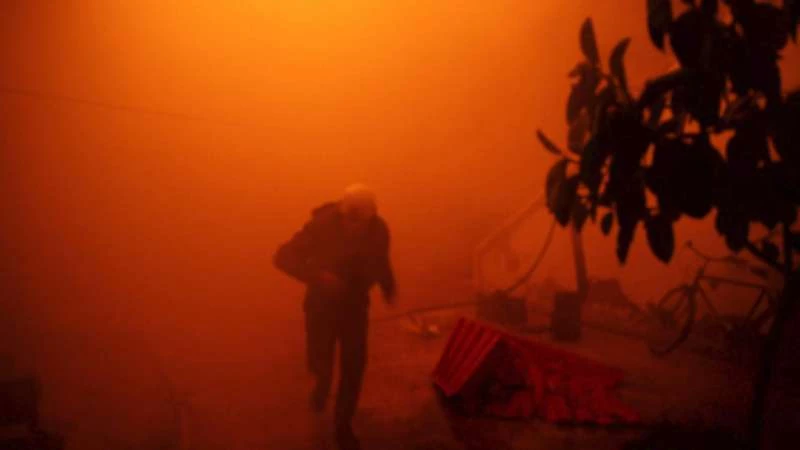However, the end of this past year witnessed a ceasefire agreement signed in Ankara with the double sponsorship and guarantees of Russia and Turkey, paving the way for the launch of negotiations for a political solution in the capital of Kazakhstan, Astana. This was a glimmer of hope for the majority of Syrians, both inside and outside the country, and reflected their desperate desire for an end to the bloodbath and their hope for a just political solution that ends the catastrophe that struck their country, caused by the authoritarian and murderous regime that does not care about human life.
The hope for salvation from the catastrophic situation has become the source of the Syrians’ hope that the year 2017 holds the promise of their emergence from the dark tunnel that is the Assad regime. The regime has punished the Syrians for over five years for their legitimate demands to be free people, like any other nation, and for them not to fear persecution by the intelligence or live under humiliation and degradation.
The Syrian protests in dozens of areas under the control of the opposition on the first day of the ceasefire was proof that their revolution will continue and they will continue to demand their rights despite everything they have been through. They chanted “Heaven, heaven, our country is a heaven. O our beloved country, with its pure soil, even your hell is heaven.”
In the event that the ceasefire succeeds in ending the Syrian bloodbath, it will be a success for Turkish diplomacy that managed to impose the legitimacy of the FSA and some of the Islamic factions on the Russians after they had sought to brand Ahrar Al-Sham and Jaysh Al-Islam as terrorists. This reflects a shift in the position of Russian politicians regarding the situation in Syria after the fall of Aleppo.
Perhaps if the ceasefire persists in the face of Bashar Al-Assad’s gangs and their allied Iranian militias, it will be followed by the lifting of the various sieges around the country and the entry of aid to over 1.5 million Syrians. This will end their suffering and the starvation imposed by the regime forces and sectarian militias for more than two years, especially in the areas of Ghouta, Zabadani, Madaya, Al-Waer and others.
The hope of 2017 holding something new that will end the suffering of the Syrians has been somewhat shaken by the lack of trust in the Russians and the plans of the Assad regime and the Iranian mullahs, as their militias and zealots have violated a number of ceasefire agreements in the past.
These gangs even violated the Aleppo surrender agreement that stipulated the forced displacement of the remaining inhabitants in the eastern districts of the city. Therefore, the Ankara ceasefire agreement is a test of Russia’s political will and the extent of their credibility and seriousness in their quest to launch peace negotiations to end the war in Astana.
It seems that Russian politicians need the support of the international community to coordinate their steps with Turkish politicians on the Syrian issue and they want to show the world that they are serious in their search for a political solution. As such, they headed to the UN Security Council, which passed, unanimously, resolution 3136 in support of the ceasefire. That now means that they also have an international mandate to take decisive steps towards negotiations in Astana and the resulting possibility of deterring the zealot Shia militias, especially Lebanon’s Hezbollah, and pushing for negotiations over a political solution in Astana. The emphasis will apparently focus on completing the existing peace talks in Geneva, according to the request of UN Envoy to Syria Staffan de Mistura.
It could be said that the horizon is open in 2017 to the possibility of finding a political solution if the Russian administration is determined to rein in the mullahs of Iran and Al-Assad’s systematic pursuit of completing this ugly war against the majority of the Syrian people. If Al-Assad continues like this, it will mean another year of the war that his regime started over five years ago against the popular revolution for freedom and dignity.
In the event that Moscow is serious in its choice to find a political solution by benefitting from the fact hat it has the longest arm in Syria – embodied by its air and naval fleets as well as its military bases and diplomatic power and strong role in the Security Council – then this will clash with the goals and plans of the Iranian regime. The Iranian regime aims to effect a demographic change in Syria and re-engineer its society in order to impose its dominance and control over the country after managing to achieve its objectives in Iraq, Lebanon and Yemen.
There is no doubt that the Turkish leadership is fully aware of what the Iranian mullahs’ have planned in Syria, as Turkish President Recep Tayyip Erdogan called, on more than one occasion, for the regime to stop its sectarian and fragmenting policies. He also warned against demographic change and this is where the Turkish-Russian understanding in Syria stems from. This is especially as Turkish and Russian voices have been raised calling for the exit of all militias from Syrian territories.
The main problem of what will become of Syria in 2017 is the extent of uncertainty surrounding the political consequences that may result from negotiations in Astana. This is because the main obstacle is the future of who will head Syria’s Ba’athist regime, as there is no way out of the Syrian disaster as long as he is present in any form. This is despite the fact that he now acts as the ringleader of the militias and had no role in reaching the ceasefire agreement that began the path to negotiations. Moscow’s politicians can actually dwarf his role to the point of non-existence.
Omar Kosh (Middle East Monitor; translated from Al-Araby Al-Jadeed)



التعليقات (0)